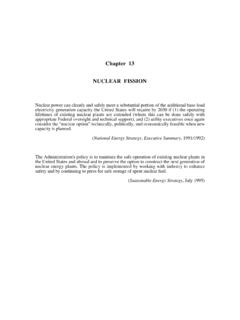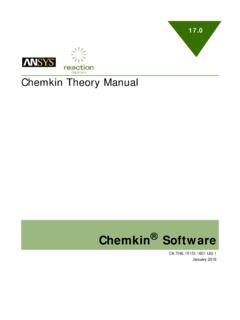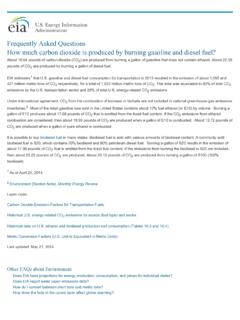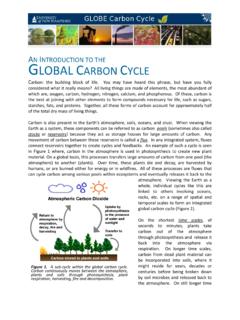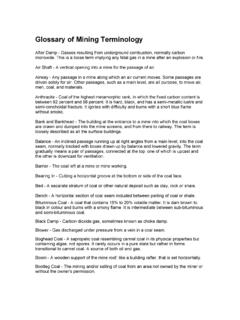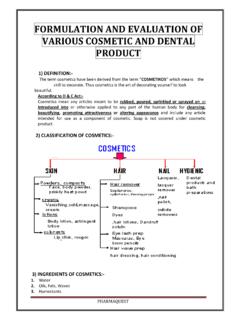Transcription of Chapter 11 FOSSIL FUELS: ENVIRONMENTAL EFFECTS
1 Chapter 11 FOSSIL FUELS: ENVIRONMENTAL EFFECTSIn air quality, the National Energy Strategy seeks to reduce energy-related emissions toachieve and maintain the National Ambient Air Quality Standards for carbon monoxide andozone; [and] to develop cost-effective, flexible control strategies to reduce energy-relatedemissions of sulfur dioxide (SO2) and nitrogen oxides (NOx). [..] The 1990 Clean AirAct Amendments [..] will limit the major air pollutants from powerplants, vehicles, andindustry. In many cases, pollutants will be reduced from current levels despite economicgrowth and increased use of energy.(National Energy Strategy, Executive Summary, 1991/1992)Energy production and use pose significant ENVIRONMENTAL challenges. Policy approachesmust align energy and ENVIRONMENTAL issues to ensure that economic growth andenvironmental protection are achieved together.
2 The Administration is reinventingenvironmental protection, creating regulatory systems that are more flexible andaccountable, emphasizing pollution prevention over end-of-pipe clean-up, and fosteringthe development of new energy-efficient technologies to meet both economic andenvironmental goals.(Sustainable Energy Strategy, 1995)192 Chapter 11It is fashionable and easy to say that we are environmentalists . The now famous 1992 Earth Summit in Rio de Janeiro has produced the environmentalist manifesto. Newsweekmagazine's cover page on June 1, 1992 said the following: No More Hot Air: It's Time toTalk Sense About the Environment. Indeed, we all are environmentalists, until it comes tomaking some tough economic and political choices, like proposing or voting for a hefty taxon gasoline. This ambivalence about the environment is clear from the careful politicalstatements quoted on the previous page.
3 You may remember how much time Congressspent debating the ambitious BTU tax in 1993 (see Chapter 21). When the dust settled,this presidential proposal was converted into a cent-per-gallon gasoline tax. Any suchtax will increase Federal revenues but will hardly do anything for the industrialized society generates an increasing amount of waste. This waste isreleased into the atmosphere, dumped into the water or buried into the earth. The pollutionof the atmosphere is primarily caused by the combustion of FOSSIL fuels in energyconversion devices. Some water and land pollution also occurs during the use of fossilfuels, but this problem is not as severe as that of air pollution and it is similar to thatconfronted by other industries (such as the chemical industry, to name just one).A pollutant is a substance usually a harmful one that is not a natural constituent ofthe environment.
4 If it does occur naturally, it is present in abnormally high principal air pollutants resulting from FOSSIL fuel combustion are the following: (a) carbon monoxide; (b) the oxides of sulfur, SO2 and SO3 (represented as SOx); (c) theoxides of nitrogen, NO and NO2 (NOx); and (d) particulates , consisting primarily of veryfine soot and ash particles. Air pollution may result also from unburned hydrocarbons;these either pass through energy conversion devices without burning or escape into the airby evaporation before they can be burnt. For many years, lead compounds contributed toair pollution, but the nearly complete elimination of leaded gasoline has reduced thisproblem primary pollutants can further interact with the environment to generate additionaldeleterious EFFECTS . Examples of these EFFECTS (secondary pollutants) are acid rain andsmog, the greenhouse effect and the high ozone levels in the air we breathe.
5 (This lasteffect should not be confused with the ozone layer depletion, which is also becoming anenvironmental problem but has no direct relationship with FOSSIL fuel utilization.)Primary Air PollutantsCarbon Monoxide. carbon monoxide (CO) is a product of incomplete combustion ofany fuel . It is both a highly poisonous gas and the principal constituent of photochemicalsmog (see below). Table 11-1 summarizes the EFFECTS of CO exposure on human main culprits of CO pollution are the urban automobiles and transportation vehiclesin general. This is illustrated in Figure 11-1. It has been estimated that some 100 milliontons of CO are emitted every year in the (see America Then and Now, Time ofFOSSIL FUELS: ENVIRONMENTAL EFFECTS1931/29/96, p. 38; see also Review Question 11-4). Use of cold engines the result offrequent short trips and of improperly tuned engines simply does not allow the carbon ingasoline to burn completely into carbon dioxide .
6 As much as 80% of today's automobileemissions occur during cold starts (see Corning Introduces System to Cut Emissions asVehicle Is Started," NYT of 2/26/96). Electric power plants (stationary sources) that burnfossil fuels cannot be turned off and on so easily (see Chapter 18), and their contribution tothis pollution problem is 11-1 Health EFFECTS associated with human exposure to carbon monoxideCO concentration(parts per million)Duration of exposure(hours)Effect10010 Headache30010 Nausea, unconsciousness60010 Death10001 Unconsciousness10004 DeathFIGURE 11-1 Typical distribution of carbon monoxide emissions by Oxides. Sulfur oxides arise during combustion from oxidation of sulfur in sulfur-containing fuels (some coals and some petroleum-based products). The principal product issulfur dioxide :S (in fuel ) + O2 SO2 Sulfur dioxide has an annoying odor and it irritates the eyes and respiratory tract.
7 Still, SO2itself is not highly dangerous. However, when it is released to the atmosphere, it can reactwith oxygen in the air to form sulfur trioxide:2 SO2 + O2 2 SO3194 Chapter 11 Sulfur trioxide irritates the mucous membranes of the respiratory tract. A concentration of 1volume of SO3 in a million volumes of air (one part per million or 1 ppm) is enough tocause coughing and choking. Sulfur trioxide dissolves in water to form sulfuric acid,which is a strong acid capable of corroding or destroying many materials. Sulfur trioxidecan absorb moisture from the atmosphere to form very fine droplets of sulfuric of these droplets can harm the respiratory system. Chronic exposure leads to amuch greater likelihood of suffering from bronchitis. Sulfur trioxide can also dissolvereadily in rain drops, and fall to the earth as acid rain (see below).
8 Figure 11-2 shows the principal culprits of SOx emissions in the United States. Figure11-3 summarizes the recent emission trends in the world and in the sulfur dioxide emissions by source.[Source: The New York Times, February 19, 1989.]Nitrogen Oxides. Nitrogen oxides have two sources. fuel NOx is produced whennitrogen atoms chemically combined with the molecules of the fuel are oxidized during thecombustion process to form nitric oxide:2 N (in fuel ) + O2 2 NOIn addition, thermal NOx is produced in some combustion processes that operate at suchhigh temperatures that nitrogen molecules in the air are oxidized to nitric oxide:N2 (in air) + O2 2 NO(Remember that air is 79% N2 and 21% O2.) When the nitric oxide is emitted to theenvironment, it readily reacts with oxygen in the air to form nitrogen dioxide : FOSSIL FUELS: ENVIRONMENTAL EFFECTS19519701980199001020304050607080s ulfurnitrogenmillion tons19851995040008000120001600020000thou sand short tonsSO2 NOxFIGURE 11-3.
9 Emissions of sulfur oxides and nitrogen oxides in the world (left) andthe (right). emissions are only from FOSSIL fuel -burning electric power convert from tons of S and N to tons of SO2 and NO, multiply by 64/32 and 30/14.[Source: Vital Signs 1996, Worldwatch Institute; Energy Information Administration.]Illustration 11-1. The annual consumption of coal in the United States is about abillion tons (see Figure 7-2). If coal had about 1% sulfur, on average, calculate the annualsulfur dioxide emissions. Compare this number with the information provided in to the chemical equation shown on page 193, for every 32 grams of sulfur in afuel, 64 grams of sulfur dioxide are formed (see Table 6-1). Therefore, remembering our elementary mathematical prelude ( Chapter 2), we have:Sulfur dioxide emissions = (64 tons SO2 32 tons S) (1 ton S100 tons of coal) (109 tons of coalyear) == 20 million tons of SO2/yearThis is more than the number shown in Figure 11-3.
10 Therefore, either the average sulfurcontent of coals used in power plants is less than 1% (see Table 7-3) or some of theSOx produced is captured before the products of combustion are released to 112 NO + O2 2 NO2 Nitrogen dioxide is a noxious gas that can cause inflammation of the lungs and, at highconcentrations, even death. In addition, nitrogen oxides will react further with water andoxygen to form nitric acid:4 NO2 + 2 H2O + O2 4 HNO3 Like sulfuric acid, nitric acid is a very strong acid that easily corrodes or attacks manymaterials. Nitric acid is also a component of acid 11-3 shows the trends in NOx emissions in the world and the United Stateswhile Figure 11-4 identifies the main culprits in the Unlike the case of SOx and CO,no particular source is to blame, because much of the emissions are thermal NOx from theair and not from the fuel , as discussed above.
